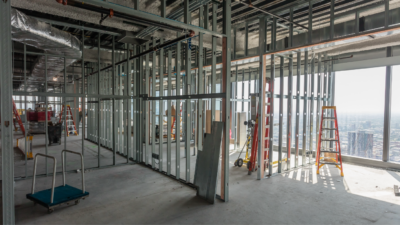The “new era” tech and creative companies—defined for our purposes as firms that have come online in the last 20 or so years, and have grown at substantial rates while subsequently expanding their office footprints—have affected arguably the two most significant components of the commercial real estate business today: the leasing of office space, and what that leased space looks like. Let’s look at the tech and creative companies that are overthrowing traditional drivers of leasing in the U.S., and how current workplace strategy trends—many of which are being driven by Tech/Creative—are influencing other sectors.
At Colliers, we’ve evaluated these trends through the lens of five key cities. If you guessed San Francisco, San Jose/Silicon Valley and Seattle, you obviously wouldn’t be wrong. But you might be surprised at just how much the new creative class has upended cities like Boston and New York, which have historically relied on more traditional industries as their office leasing stalwarts.
In the final installment of our series, we take a closer look at the San Jose – Silicon Valley market.
Read the latest report on The Impact of “New Tech” Tenants on U.S. Office Leasing
SAN JOSE / SILICON VALLEY
While we’ve uncovered new-era tech/creative leasing and workplace trends in several unexpected locations and industries, an analysis of how this sector is impacting office space just wouldn’t be complete without including San Jose/Silicon Valley. While pre-new-era behemoth Apple—the largest company in the world by market capitalization—calls the area home, so does hot-on-its-heels Google (Alphabet), as well as thousands of other technology companies, including Adobe, Cisco, Facebook, Netflix, Yahoo, Intel and many, many more. During the first quarter of 2016, San Jose/Silicon Valley saw nearly 2.5 million square feet of office leasing activity, representing a near-25 percent jump from the previous quarter but a slight decrease from the level of activity one year prior. The availability rate shrunk to 8.7 percent, a considerable decline from double-digits one year ago. The market currently has more than 6.5 million square feet of office space under construction, with total potential development reaching a jaw-dropping 53 million square feet in the form of proposed developments. New completions include office towers preleased by— who else?—Google at Moffett Place in Sunnyvale, a six-building campus that will top out at 1.9 million square feet once fully complete in 2019. And the largest new deal inked during the first quarter? Google, again, for 283,000 square feet at Moffett Towers, filling former Motorola space.
Helping to propel positive net absorption are market movers, CRE LJ CAZ, GraphPad Software, One Touch Living, Populate, Scroll Motion, ServiceNow, Socialholic Network, Strategic Data Systems and Task Retail Technology – all represented by Colliers.
It would be unheard of to discuss workplace innovation in Silicon Valley and not start with Google’s own headquarters, the 2 million-square-foot Googleplex. The list of amenities and activities offered are enough to fill a several-page report of their own, but Googlers can enjoy group cooking classes, coffee tastings, three free meals a day, haircuts, a bowling alley, cafes, swimming pools, beach volleyball and massages. Rumor has it there may actually be a few desks sprinkled throughout the campus, as well. Not to be outdone, LinkedIn’s Silicon Valley office also features a cafeteria, and the requisite ping-pong and foosball tables; it even features its own house band, comprised of full-time LinkedIn employees who enjoy rocking out together and playing music at company lunches and other events. The office areas feature lounges, of course, and there’s also a rock-climbing wall. Meanwhile multimedia company Comcast—the largest broadcasting company in the world by revenue —expanded its Silicon Valley Innovation Center, incorporating design elements from a two-dimensional electrical wiring diagram as an homage to the company’s cable beginnings, and laying the new space out as an open floor plan to drive innovation and enhance collaboration through the use of war rooms, innovation areas, game rooms, and plenty of snacks. Samsung, which was founded in South Korea in 1938, recently opened a $300 million open-plan campus in San Jose that houses research, development and sales operations for its U.S. semiconductor business. The facility includes a 10-story office tower, seven-story parking garage and a green space that links the campus together. The interior is that of a free-form bullpen, with management sitting—or standing, should they opt to use their sit-stand desks—among employees in half-height cubicles, and the open setting is rife for serendipitous encounters and ideation.
The Silicon Valley’s office market recorded its fifteenth consecutive quarter of occupancy gain. The current 8.7 percent availability rate represents a 19.3 percent year-over-year decrease. The lowest availability rate is in the Sunnyvale submarket at 3.3 percent, with Palo Alto running a close second at 4.3 percent.
The new era of tech/creative companies is not only dominating leasing lists and setting workplace strategy agendas in these major markets, but also across the country as well. Austin, Dallas, Salt Lake City, Washington D.C., and Raleigh are among some of the up-and-coming tech markets attracting companies and talent. But the likelihood of expanding to secondary markets is likely slim if a new-era company has not yet established itself in one of the big five we’ve focused on here. Then again, with the rate of new products coming online and seemingly every industry under the sun ripe for disruption, it may only be a matter of time until we see new-era tech companies driving office leasing trends and flexible workplace blueprints in completely unexpected locations.
Also: Read Part One: Overview | Read Part Two: New York | Read Part Three: Boston | Read Part Four: Seattle | Read Part Five: San Francisco
As president of National Office Services for Colliers, Cynthia Foster leads our national office platform across multiple service lines, including capital markets, tenant representation, leasing agency, property management and valuation.

 Colliers Insights Team
Colliers Insights Team
 Gary Gottlieb
Gary Gottlieb Darren Lemmon
Darren Lemmon Phil Breidenbach
Phil Breidenbach Marianne Skorupski
Marianne Skorupski Michael Lirtzman
Michael Lirtzman

 Aaron Jodka
Aaron Jodka